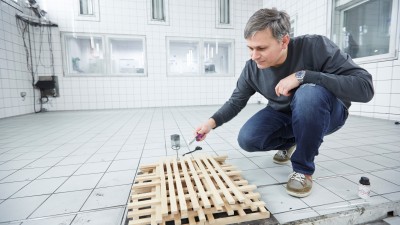Flames and smoke – a profession for more safety

Fire detectors protect lives and property and must therefore be 100% reliable. That's why Robert Rett, who is responsible for the Bosch fire laboratory in Munich, uses a system to set fires every day and has developed his own tests that ensure even greater safety for the systems.
Intentional arson
Robert Rett is completely alone in the control room of Bosch’s fire laborator y in Ottobrunn near Munich. Through a glass pane, he gazes into a white-tiled room that has polyurethane plates on the floor, and presses a button. He only triggers a small flame, but within seconds, the plastic starts to smoke, and only two minutes later the view into the room is completely blocked with thick, white smoke.
On the screen in front of him, Rett observes when and how the fire detectors mounted on the ceiling of the fire laboratory are triggered. This test, known as Fire Test 4, is one of the standard tests that all fire detection products made by Bosch Sicherheitssysteme must undergo. It is standard because it is one of many fire tests necessary to gain approval by the testing institution VdS (Verband der Sachversicherer) Schadenverhütung GmbH.

“We carry out all norm tests under the same conditions as in the test laboratory. Faults that only became apparent during the certification process would result in huge delays,” explains Rett. Faults — that might mean that fire detectors are triggered too late or not at all. It could also mean that they are triggered although there is no fire. That is a problem because repeated false alarms mean that people no longer believe they are in any danger.
The qualified electrician Robert Rett has been responsible for the laboratory for the last six years. In addition to standardized tests, he also subjects fire detectors to stress tests of his own devising.


Knowledge about fires and the way we use them here in standard conditions is not something you can train somebody for; it just takes experience.
“Fire detectors protect life and property and must therefore be reliable,” says Rett. For the last six years, the qualified electrician has been responsible for precisely that in the fire laboratory. “Knowledge about fires and the way we use them here in standard conditions is not something you can train somebody for; it just takes experience,” explains Rett. This is exactly what fascinates this level-headed man, who is now piling up small logs for the next test.
Every time he works in the fire laboratory, there are different products or different conditions being tested. Today, in addition to a range of fire detectors, three AVIOTEC cameras, which are used to facilitate video-based early fire detection, are suspended from the ceiling. They are among the latest Bosch developments for public and industrial use in enclosed spaces: The networked cameras can reliably detect smoke and flames — as already shown in the first test, it is these cameras that report the fire in the laboratory first.

“AVIOTEC cameras are IP-based and can be used via a shared user interface within the network, which we have set up especially for this purpose. The system is then put through its paces,” explains Rett. Spotlights that shine directly into the camera have been set up. Various ventilation conditions have been simulated using fans that blow the smoke in all directions. Photo canvases have been used to see if AVIOTEC can detect fires correctly even against different backdrops.
Rett also carries out this kind of especially conceived tests for conventional fire detectors. He refers to them as “disturbance tests,” and they often consist of him using cigarettes, sparklers, or steam to test the alarms’ reliability. Tests of this nature are not legally required, but as Robert Rett knows from experience: “Better safe than sorry.”



